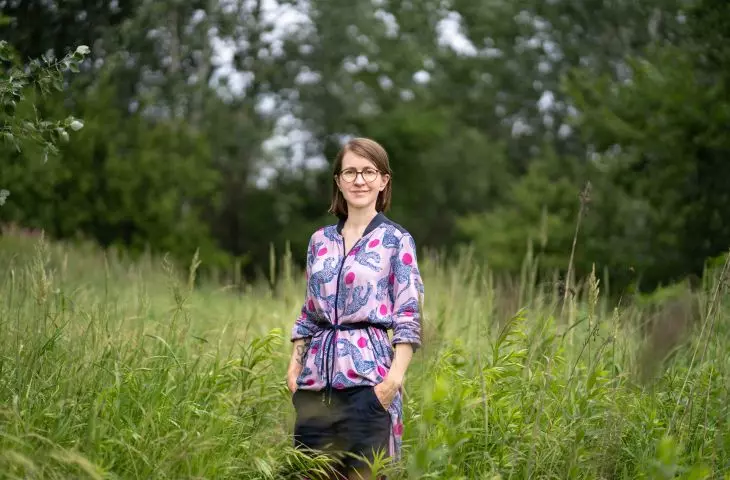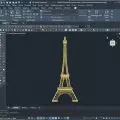Wiktor: You recently released a report on urban farms and the edible city. What is this concept based on?
Joanna: The edible city is a concept that the vegetation we have in the city can be used not only visually or to lower the temperature, but it's also something we can eat. The idea is not to bring in the cornfields at Wawel Castle or under the Palace of Culture, although that would be spectacular, but to return to what incities has been before — a time when fruit trees such as apple, plum, mirabelle, cherry and cherry trees are present in our streets and yards, and their fruits processed into jams, preserves and drinks. Greenery in the city does not have to serve only a representative function, an extreme example of which is a row of thuyas on a perfectly trimmed lawn, which is supposed to show that someone belongs to the middle class and knows how to keep things tidy.
It's also a shift in thinking about where food comes from and showing that it's not just the countryside or the supermarket that can provide us with food, but also the cities. In our report The Cooperative Urban Farm as a Tool for Developing the Urban Food Zone and Agroecology, in addition to the cooperative urban farm model, we show solutions that bring food into the city.
An example of a typical urban farm is the Krakow Urban Farm operating under the RWS model, or Socially Supported Agriculture. In it, we buy parcels, paying for the crops at the beginning of the season — in this way, it's the customers, taking the risk. In this way, we better begin to understand how weather affects agriculture.
We also show forms of educational activities that are carried out in schools or kindergartens, organizing school gardens. Such farms are also appearing at universities, with Adam Mickiewicz University in Poznan leading the way. The university is currently involved in the development of the farm.
illustrations by Gosia Zmysłowska
© CoopTech Hub
An interesting way of thinking about food in the city is agriparks, or recreational areas that look just like parks, but that greenery between the alleys are crops. Such a city best known for agriparks is the French city of Montpelier, where the first agripark was created at the initiative of the city. It was intended to preserve the regional character while serving as an accessible public space. In Montpelier, the main part of crops are vineyards. In Poland, we are incubating an agripark in Książenice, a town near Grodzisk Mazowiecki. There, urban agriculture is an element of the planned housing development will be built. The investor is the Champions Park company, associated with the Legia Training Center, a training center for soccer players, adjacent to the planned development. We are currently working on planning how to keep the existing greenery to the maximum and planting new edible trees and shrubs.
The other very interesting planned development, which is not in our report because it has a small agricultural component, is the development being designed in Chrzanow, where Aleksandra Wasilikowska 's project includes not only community gardens, but also a fungarium.
Wiktor: A fungarium?
Joanna: Yes, a fungarium. There will be cultivation of mushrooms, for example oyster mushrooms, which are an excellent source of micronutrients. Functional foods can also be introduced — the recently popular supplements made from soplum ursinum or matzoh-beetle. Speaking of food in the city, de facto, we are moving between the use of public areas. Some of it will be private, some cooperative and some public.
The other direction is to go into high-tech agriculture, such as hydroponics. In the report we cite the example of a startup like Listny miracle. There's also an example of aquaponics from Bologna by a house that has housed people in a homelessness or refugee crisis.
Logistics are an important part of this system. Examples include both food cooperatives, such as Warsaw's „Well” cooperative, and local markets, such as Krakow's Parsley Market.
The future of agriculture according to CoopTech Hub
© CoopTech Hub
An interesting example of bringing food into the city is an initiative from Tarnowskie Góry. An ancient species of apple tree there has been restored, which is called Piękna z rept, after the name of the former palace estate of Repty (and now a district of Tarnowskie Góry), where the variety was bred. Several years ago, the city government, encouraged by local community organizations, grew several hundred seedlings, which were distributed to residents.
An important element visible in our report is the theme of farms, which are hortiterapeutic farms. Through contact with nature, they perform a therapeutic function. A good example is the Manufaktura Ogrody Sitowie, where single mothers with children and people with disabilities are engaged in growing vegetables, mainly cucumbers, beets or Chinese cabbage. They create various products from them, which, by the way, can be purchased from them at siejemyferment.pl
Another aspect of hortiterapeutic influence is the creation of sensory experiences. An example is the paths designed in Dąbrowa Górnicza organized by the Ósmy Dzień Foundation, bringing together people with Down syndrome and their families. This is an example of building resilience, not only in the economic model, but also in the mental model.
The development of urban agriculture is a step toward raising the level of public health Contact with nature allows us to better recover and build mental resilience, and movement also positively affects our physical health An important element of resilience for each and every one of us, no matter whatwhat position we work in, how much money we have is to take care of our bodies, because contrary to the Enlightenment belief, we think not only with our minds, but also with our „body-minds,” where we know very well that when we are sick, it is very difficult for us to cope with the challenges that reality brings us — those constant novelties.
This is also where the cooperative model works, when we are owners in a cooperative, we feel that this piece of land is partly ours, so even more than with public spaces, we feel that we have a right to be here.
Wiktor: Do we need ownership even here?
Joanna: When you have a cooperative urban farm, you know that you can come there, work and relax, but also make a party or a birthday party there. You feel part of the community. On top of that, you have much more influence than you do on how public green spaces are managed. On the other hand, there is also an economic aspect. If you have two pubs — you can buy products and use other services and make money at the same time. Imagine you have two pubs: one is cooperative and you have shares and you know that by spending there, you multiply your wealth, plus you get a discount; the other operates in a market model. Unless he wants to avoid his friends, the choice is obvious.
Wiktor: To what extent can urban farms feed cities?
Joanna: It certainly can't feed us fully. It's not that we should stop using the environment. Paris is currently in the process of dedicating 30 hectares of land, which is three percent of the city's area, and this will help feed about 10% of Parisians, which is quite a lot.
The report emphasizes that there are farms around our cities, and that our goal should not be to separate ourselves from the countryside, but to support male and female farmers to shorten supply chains. It's not about locking ourselves into cities like capsules and saying we're giving up on agriculture, it's about raising awareness of how important it is.
It's much easier to have conversations about the strategic role of agriculture the moment you know where vegetables and fruits are coming from. There are several intermediary chains between farmers and farmers and us, some of which are large corporations. Building universal prosperity is building a democracy where we all feel we have more agency. We look at our report on agriculture more broadly, to the concept of ecopolis — showing that the city is a part, but we don't unplug from farmland. The urban-agricultural alliance is the basis of food sovereignty, and it will only be possible if we meet face to face.
Sustainable food system strategy for the city of Warsaw
© CoopTech Hub
Wiktor: That is, what the market in Oliva is proposing, or the implementation of the Aleksandra Wasilkowska you mentioned in Blonie. You are starting the Warsaw Food Cooperative project — at what stage are you?
Joanna: We are at the stage of leasing the land that the city has identified as a potential location. It's about three hectares in Siekierki after the former allotment gardens, which were removed more than twenty years ago to build the Siekierkowska Route. Hopefully, we will start in the autumn. You can say that we are prepared, because there are already community gardens in Warsaw such as Motyka and Sun. We have strong support from the SGGW. Pioneers and pioneers of urban agriculture are the core of our future cooperative.
We actually incubated while working with Champions Park and Legia Training Center during the creation of agriparks, was the first result of the conversations we had while creating this report. A cooperative urban farm is not just about food production, but a place for education, creating an experience space or taking part in an urban harvest festival.
We try to turn problems into potentials. Currently, my colleague and co-author of the report Maciej Lepkowski is in talks with one of the people at the SGGW about using goldenrod, an invasive species, to make plywood boards from it. Designers and designers can be invited to join. We are also looking for other ways to get rid of goldenrod. A proven way is to graze sheep, which opens up the imagination that perhaps an important profession will soon be the urban shepherd. This seems very abstract, but sheep already perform horticultural functions, for example in Dusseldorf.
Wiktor: In Edinburgh they also perform such functions.
Joanna: With photovoltaics in Denmark, they are also used. They are better than goats, because goats jump on the panels and destroy them. Going forward, how do we then have urban wool, fertilizer and a new profession of the future. Urban gardening can also create new jobs — like the aforementioned urban shepherd, or another occupation related to wool processing. There is ample space here, too, for educators to teach urban-farming innovations.
© CoopTech Hub
Wiktor: We've talked about cooperatives and urban farms, and what are your future plans as CoopTech Hub.
Joanna: To continue developing and testing different cooperative models. For example, building energy cooperatives in villages and cities. We are looking forward to urban energy cooperatives. We are in the process of finishing a report for Krakow on model solutions with concrete calculations. We are developing cooperation in cities and hope to be able to show new solutions in the fall. We are also working on digitization processes — not only for local governments, but also for trade unions. In the spring we created, in cooperation with the All-Poland Alliance of Trade Unions, a chatbot — the lioness Hope — that guides you through the labor code. You can talk to Hope on the website pracujgodnie.pl. So we are working for broad cooperation and strengthening democracy. However, we treat cooperatives as our main area of activity, because we believe that cooperatives are the best vehicles for development not only by their democratic nature, but because it is the only legal form that allows the inclusion of various actors — companies, other cooperatives, NGOs or individuals. Cooperatives are a capacious format that allows to connect everyone who wants to build a better world together.
Wiktor: Thank you for the interview.









































